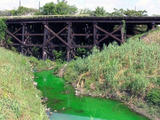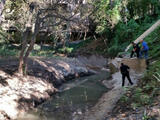Resources
- City of Houston 311
- City of Houston Code of Ordinances
- Houston Wastewater Monitoring
- Pollen and Mold Reports | HHD
Page last reviewed: February 6, 2024
Environmental Monitoring
Surveillance
The Bureau of Pollution Control and Prevention is an air pollution control program that was established in 1967 to help abate air pollution in Houston. The Water Pollution Control program that was initiated in 1973. The revised City of Houston Smoking Ordinance became effective on September 1, 2007.
Complaints
Call 311 or go to Houston 311.
Air Monitoring
Funded through grants from the U. S. Environmental Protection Agency (U.S. EPA) and the TCEQ, we operate and maintain an ambient air monitoring network for Houston that follows the U.S. EPA protocols and quality assurance/control procedures. This network is part of a broader and more comprehensive system that includes facilities operated by the TCEQ, area counties, nearby cities and private entities. The bureau is responsible for monitoring up to 20 different parameters at 10 stationary air monitoring sites throughout Houston.
Parameters include:
- Ozone
- Sulfur dioxide
- Carbon monoxide
- Nitric oxide
- Nitrogen dioxide
- Oxides of nitrogen
- PM 2.5 (particles with diameters less than or equal to 2.5 micrometers)
- PM10 (particles with diameters less than or equal to 10 micrometers)
- Wind speed
- Resultant wind speed
- Resultant wind direction
- Wind gust
- Standard deviation of wind direction
- Outdoor temperature
- Relative humidity
- Dew point
- Solar radiation
- Ultraviolet radiation
- Barometric pressure
- Precipitation
Eight of the 10 stationary air monitoring sites have trailers that house air collection apparatus that includes analyzers, calibrators and a computer data logging system that allows bureau’s investigators and TCEQ personnel to view real time data. Specialized equipment, strategic locations and adherence to U.S. EPA-approved operating standards are among the important influences that allow monitoring stations to be a critical component of the clean air effort. Learn more about what goes on at an air monitoring site.
In some air monitoring sites the TCEQ uses Automated Gas Chromatographs (AutoGCs) to measure ambient levels of around 50 volatile organic compounds (VOCs), including some air toxics.
Maps of air monitoring sites and summary reports of the hourly data collected at each site
- Daily summary report (TCEQ)
- Monthly summary report (TCEQ)
- Yearly summary report (TCEQ)
- Data collected by AutoGCs (TCEQ)
The U.S. EPA uses the bureau’s ambient air monitoring information and other data to calculate the Air Quality Index (AQI) for reporting daily air quality. It indicates how clean or polluted the air is and relates the associated health effects that may be a concern to humans and the environment. The AQI focuses on health effects you may experience within a few hours or days after breathing polluted air.
The U.S. EPA calculates the AQI for five major air pollutants know as criteria pollutants regulated by the Clean Air Act (CAA): ground-level ozone, particle pollution (also known as particulate matter), carbon monoxide, sulfur dioxide and nitrogen dioxide. For each of these pollutants, U.S. EPA has established National Ambient Air Quality Standards (NAAQS) to protect public health. The TCEQ monitors four criteria pollutants using the AQI: ground-level ozone, particulate matter, carbon monoxide and sulfur dioxide.
Criteria pollutants in the City of Houston network
Ground-level ozone is created by chemical reactions between oxides of nitrogen (NOx) and volatile organic compounds (VOCs) in the presence of sunlight.
Particulate matter (PM) is a mixture of solids and liquid droplets in the air that vary in size. PM 2.5 or “fine particles” are very small particles with diameters less than or equal to 2.5 micrometers. PM 10 are particles with diameters less than or equal to 10 micrometers. Go to air quality guide for particle pollution (U.S. EPA AIRNow) .
Carbon monoxide is a colorless, odorless gas that is formed when material containing carbon is not burned completely.
Sulfur dioxide (SO2) is one of a group of highly reactive gasses known as “oxides of sulfur.”
Nitrogen dioxide (NO2) is one of a group of highly reactive gasses known as “oxides of nitrogen” or “nitrogen oxides” (NOx).
Nitrogen dioxide (NO2) is one of a group of highly reactive gasses known as “oxides of nitrogen” or “nitrogen oxides” (NOx).
AQI conditions and forecasts for the Houston-Galveston-Brazoria area
Call 832-393-5612 for our morning air pollution forecast recording. The recording is updated each weekday morning by bureau’s personnel, and is based on daily forecasts by the TCEQ. These forecasts are available at today’s ozone forecast (TCEQ) and today’s Texas air quality forecast (TCEQ) . The recording describes the air pollution level for the day as low, moderate, or elevated.
- Houston metropolitan area AQI (TCEQ)
- Houston-Galveston-Brazoria air quality conditions and forecasts (U.S. EPA AIRNow)
- Ozone Viewer (Houston Clean Air Network)
- Texas ozone data (TCEQ)
- Houston-Galveston-Brazoria fine airborne particulates (PM-2.5) levels (TCEQ)
Water Monitoring
Clean Rivers Program
Complaints:
If you observe any water pollution or fish kill, call 311 or our office directly at 832-393-5730. Our environmental investigators in the Clean Rivers Program will respond and investigate.
Program goals:
- Conduct ambient surface water monitoring of all sites and submit all deliverables per H-GAC Clean Rivers contract.
- Respond to and resolve all citizen complaints within prescribed timelines.
- Proactively identify and mitigate surface water quality issues through review of data and joint projects with other agencies.
- Conduct and participate in outreach, training, and professional growth opportunities.
Links:
- Texas Clean Ribers Program: History and Overview | An overview of how the program works, how the public participates, and why the program uses a watershed management approach.
- Houston-Galveston Area Council: Clean Rivers Program | The H-GAC Clean Rivers Program is in charge of conducting water quality monitoring and assessment to determine the health of water bodies throughout the region. H-GAC does this through a coordinated effort with local partners and the Texas Commission on Environmental Quality (TCEQ).






